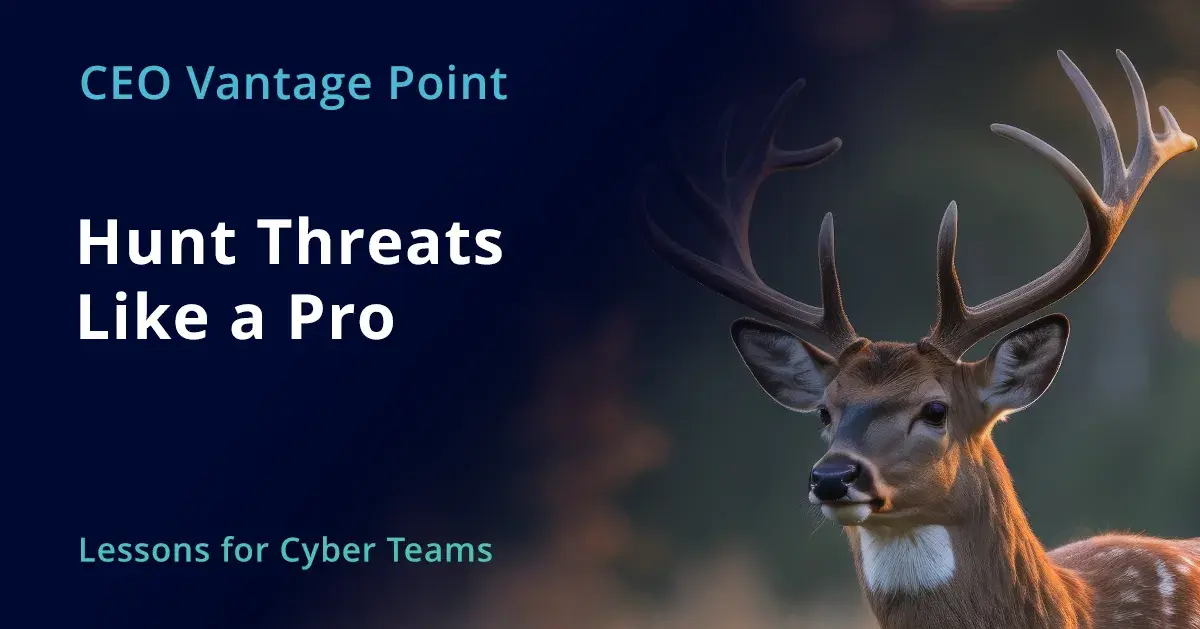
Threat hunting is hard. It requires training, intuition and expertise. Teams need to know adversary tactics, where threats hide, and how to eliminate them.
What Makes a Great Hunter?
Depending on where you live, fall hunting season isn’t far off. The preparation has already begun: scouting territory, tracking signs, and hoping to spot that trophy buck. Many hunters set trail cameras in advance, hoping to capture images of a 6x6 stag feeding nearby. Sometimes, of course, the camera only picks up a squirrel.
Some cameras require you to retrieve a memory card, while others conveniently send images to your phone. But having a trail camera alone doesn’t make you a great hunter—it only confirms that something might be in the area. True hunting requires much more.
A skilled hunter understands the animals’ habits, where they sleep, how they travel across terrain, and how they sense predators. They prepare carefully—using camouflage, masking scents, and learning how prey evade danger. They combine knowledge, experience, and the right tools. Most importantly, they often learn from a seasoned guide who has mastered the art of the hunt.
The Illusion of “AI Hunting”
In cybersecurity, the same principles apply. We often see vendors promoting tools—or worse, “AI-powered” solutions—that claim to do the hunting for you. It’s like imagining a trail camera that guarantees you’ll bag a deer every time you go out. Reality doesn’t work that way.
Threat hunting is hard work. It requires training, intuition, and human expertise. You could duct tape an iPhone to a tree and hope for results, but it’s expensive, poorly suited for the task, and probably in the wrong spot. Similarly, many network detection and response (NDR) tools weren’t designed for real hunting. A 28-page manual explaining how to “make it hunt” isn’t hunting—it’s just using captured data more effectively to detect what already happened. You will not go home with a trophy Advanced Persistent Threat (APT) with that strategy.
Why Experienced Guides Matter
The traditional way to improve your odds in the field is to hire an experienced guide. Guides know the terrain, understand animal behavior, and can anticipate evasive moves. They bring the best gear and help fill in gaps in your own skills. In short, a good guide dramatically increases your chances of success—far more than buying a new, “smarter” trail camera.
The same is true in cyber threat hunting. At PacketWatch, our team acts as your professional guide. We don’t just rely on tools—we hunt every day across business, government, and non-governmental organizations (NGO) networks worldwide. Our team knows adversary tactics, where threats hide, and how to eliminate them with precision.
And like any great guide, we bring the right gear. Our proprietary threat hunting platform was built by hunters, for hunters. It ensures we can identify and respond effectively to the most sophisticated threats.
Scout the Area
A successful hunter often starts with a good topo map and identifies areas where the animals are likely to water, feed, and sleep. When they get on site, they use their spotting scope to meticulously survey the area and look for signs of movement to verify their hypotheses about the best place to locate. That clear visibility develops into an effective hunting strategy. You need to anticipate where the animals will be, not just where they were yesterday.
Likewise, the PacketWatch platform maps out the network, assets, and communications of target organizations. It does so quietly in the background, analyzing each packet that crosses the wire. It identifies likely places of activity for a hunter to investigate and things that just don’t look right. The platform provides the hunter insights and integrations into other security tools like CrowdStrike Falcon to enhance context. Machine learning models speed the coverage of massive amounts of data collected. PacketWatch AI makes it easier to comb through comprehensive data sets rather than trying to infer something from limited data like others. The result is high-fidelity “hunt leads” that direct your team and their guide to where they can find the trophy in the herd.
The Takeaway
If you want to succeed this season, don’t rely on flashy “AI” trail cameras that overpromise or expensive, overengineered tools. Success comes from working with skilled professionals who bring the best gear, know the terrain, and have the right experience.
For cyber threat hunting, that means choosing PacketWatch as your guide and your hunting platform. We combine daily proficiency, proven expertise, and a purpose-built technology platform to help you stay one step ahead of adversaries. Get the one that is built for the hunt by the hunters themselves.
Leave the AI-powered trail cam on the shelf. Happy hunting!
Need Help?
If you’re frustrated with the results of your current cybersecurity strategy and want a more proactive approach, give us a Call today. Let us show you how we can help you take control of your cybersecurity.
Chuck Matthews is the CEO of PacketWatch, a cybersecurity firm specializing in Threat Hunting and Incident Response, leveraging their proprietary network monitoring platform. With over 35 years of executive experience, Matthews excels in aligning technology with strategic business goals and is a recognized leader in cybersecurity. Chuck has contributed to numerous publications and media outlets, focusing on topics like cybersecurity legislation and best practices.
Posts by Tag
- CEO Perspective (30)
- Cybersecurity Resilience (12)
- Incident Response (12)
- Compliance (10)
- GRC (9)
- Vulnerability Management (7)
- Best Practices (5)
- Threat Hunting (5)
- Cyber Insurance (4)
- Artificial Intelligence (AI) (3)
- Full Packet Capture (3)
- HIPAA (3)
- Artificial Intelligence (2)
- Network Visibility (2)
- Ransomware (2)
- Critical Vulnerability (1)
- Cybersecurity Threats (1)
- Event (1)
- Legal Industry (1)
- Manufacturing Industry (1)
- Multi-factor Authentication (1)
- Security Risk Assessment (1)
- Threat Intel (1)
- Zero-Day (1)

.webp) Chuck Matthews
Chuck Matthews